Water, sanitation, hygiene (WASH) and inclusive education
Ingrid Lewis
Why have we decided to publish a special section
on water and sanitation issues?
I have developed a growing interest in the issue of water, sanitation and hygiene (WASH) and how it links with inclusive education. My interest started with an action research project that EENET was involved in, with schools in Zambia. We carried out various image-based participatory activities with school children. They were asked to photograph, draw, map or make a drama about places in school that make them feel included or excluded, welcome or unwelcome, safe or unsafe. Every group mentioned the school toilet and water facilities in some way! Most found them to be unwelcoming or unsafe places. The school children mostly concluded that to make their school more inclusive for all learners – girls and boys, younger and older, disabled and nondisabled – the water and sanitation arrangements needed to be addressed and improved.
The children’s insights and analysis helped those involved in the project to move beyond the most obvious issues that their teachers or other adults tend to see, such as toilet buildings being inaccessible to wheelchair users.
The children told us about the issues shown in the diagram on the next page. The issues mentioned in this diagram by no means cover all the ways in which WASH facilities impact on the quality and inclusiveness of education. The diagram does, however, begin to show the importance of WASH issues for anyone striving to deliver better quality education for all. It also shows the breadth and depth of analysis that is needed by anyone trying to ensure that WASH arrangements really do meet the needs of all learners.
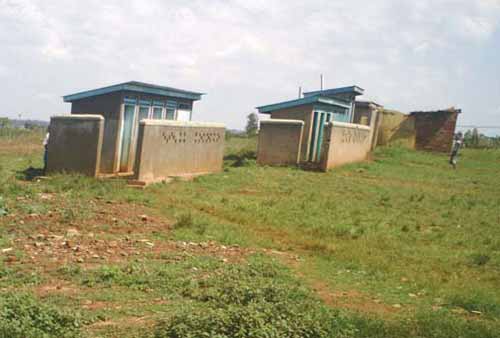
Latrines at Agururu Primary School, Uganda (photo taken by school pupil)
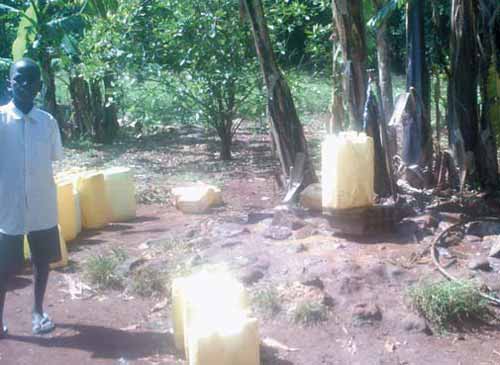
Water collection point, Agururu Primary School, Uganda (photo taken by school pupil)
The need for greater collaboration
We received fewer articles than expected for this newsletter special section. Those we did receive covered quite a narrow range of issues – compared to those that children have identified (shown in the diagram). I feel this demonstrates a clear need for more research and action on the issue of ‘WASH and inclusive education’, particularly around the impact that WASH provisions – at home and school – have on children’s presence, participation and achievement in the learning process.
There is a strong case for greater collaboration between WASH and inclusive education experts. This is needed to help bring the two areas of work together more effectively:
- to enable WASH programme planners and implementers to understand and address the full range of ways in which WASH affects a child’s learning opportunities and progress
- to build the capacity of inclusive education practitioners to not only identify, but also find appropriate, cost-effective solutions to barriers to inclusion that stem from WASH problems in schools and the wider communities.
It has become something of a cliché that development initiatives have more impact when there is ‘joined-up thinking’ between the various components. In the case of WASH and inclusive education, this couldn’t be truer. The people who work on WASH projects usually have very different skills, experiences and perspectives from those involved in inclusive education initiatives.
The two fields of expertise and interests rarely overlap consistently or extensively enough for either side to learn about each other’s issues. I’m not saying that WASH planners or engineers need to become education specialists, or that education officials and teachers need to learn how to design and build WASH facilities.
But the two sides need to develop greater awareness of each other’s existence and work together more effectively and consistently. They need a shared:
- purpose
- vision for what learners need from WASH provision
- approach to participatory methodologies that enable children, parents, teachers, etc, to be at the heart of all efforts to improve WASH provision in a way that helps deliver better quality education for all.
Without this level of awareness, understanding and collaboration there is a risk that WASH and education work will involve two groups of people who never quite understand each other. They may never quite link their ideas and actions together, and may potentially offer their stakeholders a disjointed and incomplete solution to those WASH issues that present barriers to learning and participation. By not working together to create inclusive WASH facilities at the start, they also face the more expensive option of having to adapt and improve facilities later on.
A major gap in this special newsletter section is the issue of WASH in schools/learning spaces during or following emergencies. We tried to source some articles, but were unable to do so in time. We therefore invite readers who are working in emergency and post-emergency situations to send us articles for our website or for the next newsletter.
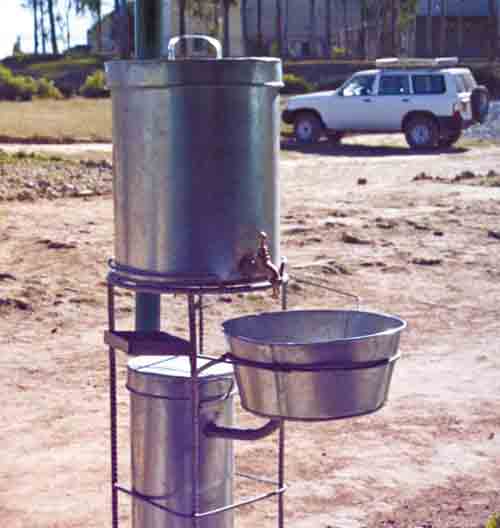
Water supply, Nyanji Primary School, Zambia (photo taken by school pupil)
Lack of privacy: especially worrying for girls who often drop out of school
as a result. See the article about menstruation and girls’ education in Nepal on p.22 of EENET’s 2009 newsletter: www.eenet.org.uk/resources/eenet_newsletter/news13/page16.php
Health fears:
- when toilets/latrines are not kept clean and hand washing after using the
toilet is not possible or inadequate - when children are given or sold unhygienic food in or near school.
See pp.18-19 for an article about a hand washing programme in Indonesia which raises awareness among school children and families about the importance of, and methods for, good hygiene. It has also used competitions and child-to-child approaches to promote cleanliness.
An example from Tanzania
“The School WASH partnership (comprising SNV Netherlands Development Organisation, WaterAid, UNICEF and CCBRT … noted widespread inadequacy of WASH facilities in many areas of Tanzania … They mapped eight districts…There was … a severe lack of soap and only 10% [of schools] had sufficient water for hand washing.”Extract from an article by Comprehensive Community Based Rehabilitation in Tanzania, available on EENET’s websitewww.eenet.org.uk/resources/docs/wash_tanzania.doc
Inaccessible toilets, washing facilities, and tap areas – due to steps, narrow doors, bumpy paths, slippery surfaces and inappropriately designed hardware.
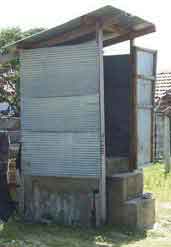
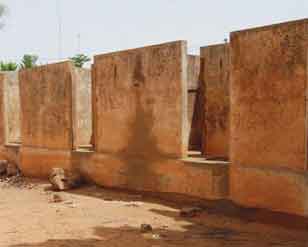
Some examples of inaccessible facilities
Fetching water for use in school, for their teachers, or for families leaves children tired and less able to learn in class.
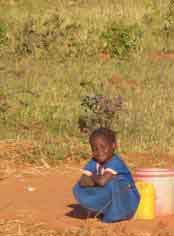
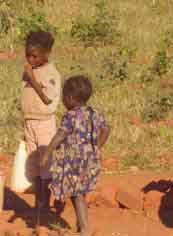
Girls fetching water near a school in Zambia
Strict rules about using toilets or water facilities can make children feel uncomfortable or unwelcome in school.
Bullying: children are often affraid of going to the toilet at school because of bullying and anti-social behaviour.
Unequal access: sometimes the best toilets are reserved for use by a few teachers, while hundreds of children must use a few very poor toilets.
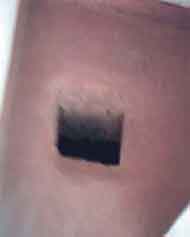
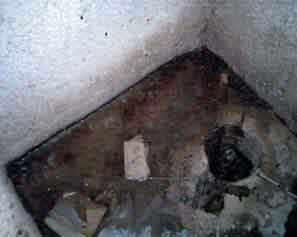
Children in Zambia photographed the difference between teachers’ and pupils’ toilets
Hungry and thirsty children do not learn well in class.
An article on pages 14-15 describes a programme to provide clean, safe drinking water to school children in Ethiopia and the positive impact this has had on their learning. The article does, however, highlight that some children only consume water all day because their parents can’t afford to send them to school with food. Yet hunger can also cause equally big barriers to effective learning.
Shauri Saleh Bakar from Zanzibar sent EENET a letter in which he highlights
the importance of food if we are to ensure education for all:
“My school has enough water and toilets but we have no habit to give food to pupils with disabilities… [which] affects education in a bad way: [Pupils] sleep too much in the classroom; [it] causes truancy when pupils go to find food at home; and children do not understand the lesson when they are hungry.”
An article from Indonesia (see pp.18-19) and Shauri’s letter show the importance of developing holistic programmes that address both the nutrition and water needs of school children, to ensure learning and participation.
Bad smells from latrines and rubbish pits distract children in class, affecting their concentration and learning.
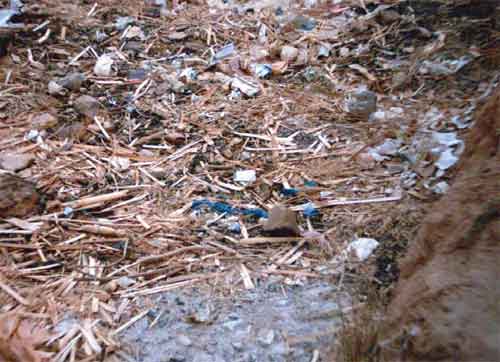
School rubbish pit (photo taken by children in Zambia)
Poor community facilities for hygiene and sanitation can lead to illnesses that cause children to miss school. Community members may also use the school facilities if they have none at home, causing extra damage or extra mess. Schools may even keep toilets locked to avoid this.
See the drawing on p.21 by Abraham from Ethiopia showing a cycle of poor hygiene, illness and school absenteeism.
| Support from WaterAid
WaterAid is very happy to support EENET with this issue of the newsletter as we are working hard to promote good access to safe water, sanitation and hygiene in schools. We know that children’s health and education suffer when they do not have access to safe water, sanitation and hygiene. Children are particularly vulnerable to diarrhoeal diseases as well as worm infection, skin diseases, trachoma, typhoid, and Hepatitis A. All of these conditions affect their long- term development, and many school days are missed because of sickness. The issues highlighted in this newsletter show how important it is to provide access to safe water, sanitation and hygiene in schools. It benefits everyone – staff and students, girls and boys, people with and without impairments. Inclusive school water, sanitation and hygiene provision supports good education for everyone. Also, when children learn about good hygiene at school they often take the messages back to their families to improve hygiene at home. WaterAid’s vision is of a world where everyone has access to safe water, sanitation and hygiene – and this includes children. For more information about WaterAid’s work see our website: www.wateraid.org |
EENET is grateful to WaterAid for helping to finance the production of the special WASH section in this newsletter.
